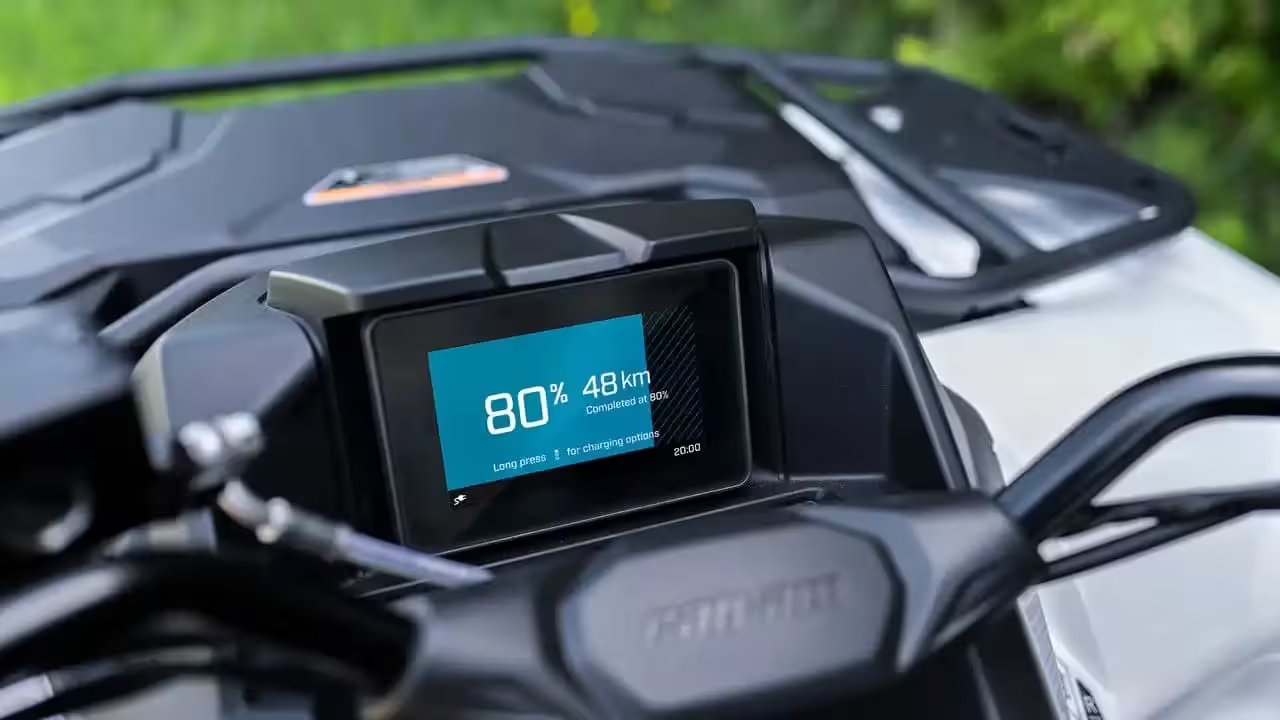5 Minutes
Introduction
BRP has expanded its electric powersports portfolio with the 2026 Can-Am Outlander Electric, a purpose-built all-terrain vehicle that challenges gasoline rivals on capability while delivering the low-noise, low-emission advantages of electrification. Using BRP’s modular Rotax E-Power architecture, the Outlander Electric is aimed at farmers, hunters, park managers and recreational riders who need robust towing and utility performance without the roar of a combustion engine.
Key Specifications
The new Outlander Electric positions itself as a utility-focused electric ATV with figures that compete directly with—and in some cases exceed—top gasoline models.
Powertrain and Performance
- Electric motor: 47 hp (35 kW)
- Torque: 53 lb-ft (72 Nm), tuned for utility and quick response
- Selectable ride modes: Normal, Sport, Work for adaptable throttle mapping and vehicle behavior

Battery, Range and Charging
- Battery capacity: 8.9 kWh
- Estimated range: up to 50 miles (80 km) under mixed use
- Charging: 20% to 80% in approximately 50 minutes using a Level 2 charger
Towing and Utility
- Towing capacity: 1,830 lbs (830 kg) — a workhorse figure that outperforms many gasoline competitors

Design and Quiet Operation
Unlike conversions that graft electric systems onto legacy frames, the Outlander Electric is built on BRP’s in-house Rotax E-Power platform—the same modular drivetrain underpinning the company’s recent electric motorcycles and snowmobiles. That ground-up electrification allows packaging and engineering choices that reduce noise, improve serviceability, and optimize the riding experience.
Noise reduction is a headline feature: XPS Recon Force tires, a low-noise liquid-cooling system, and suspension tuning combine to deliver a near-silent ride. The result is an ATV that can operate around livestock, glide through hunting grounds, or patrol parks at dawn without disrupting wildlife or neighbours—an important selling point for users in noise-sensitive environments.
Performance and On-Trail Behavior
The 47-hp electric motor and immediate electric torque give the Outlander Electric strong off-the-line response and useful pulling power for trailers and implements. The three ride modes let owners dial in performance for trail enjoyment (Sport), everyday riding (Normal), or heavy work tasks (Work). Suspension geometry and damping were reportedly optimized for the electric package, maintaining nimble handling while carrying loads or towing.

Market Positioning and Comparison
With a towing capacity that tops Can-Am’s own gasoline top-shelf ATVs and edges out rival models from brands such as Polaris and Honda, the Outlander Electric stakes a claim in the utility ATV segment. BRP’s strategy is not limited to a single model: the Outlander joins the company’s growing electric roster, which includes the Can-Am Pulse and Origin electric motorcycles, several Ski-Doo and Lynx electric snowmobiles, and even an electric karting powerpack.
Electrek’s commentary highlights the rarity and potential impact of electric ATVs. Compared with traditional gas ATVs—useful but noisy, maintenance-intensive, and polluting—the Outlander Electric demonstrates that electrified workhorses can match capability while offering quieter, cleaner operation. The principal obstacle remains price and adoption: early electric UTVs and ATVs sometimes carried premium price tags, which constrained uptake despite their advantages.
Price, Availability and Practical Considerations
According to Can-Am’s listing, the Outlander Electric is available now through Can-Am dealers and online. The model is priced following Can-Am’s positioning of the vehicle as a premium, purpose-built electric utility ATV. Early buyers will weigh the benefits of lower operating noise, reduced maintenance, and zero tailpipe emissions against purchase cost and charging infrastructure needs.
For many commercial users—ranches, parks, and service fleets—the reduced maintenance burden and quieter operation could produce a fast return on investment. For recreational riders and hunters, the stealthy operation and instant torque present compelling new use cases.

Conclusion
The 2026 Can-Am Outlander Electric signals BRP’s serious push into electrified powersports: a ground-up electric ATV with strong towing capacity, practical range for daily tasks, and the quiet operation that opens new use scenarios. Whether it accelerates broader adoption will depend on total cost of ownership, charging access, and how many buyers prioritize the benefits of electrification over traditional gasoline convenience.
“With the Outlander Electric, we’re not just launching a new ATV, we’re introducing a new way to experience the outdoors and get the job done,” said Julie Tourville, Director, Global Marketing, Can-Am Off-Road at BRP. “This vehicle is built to let riders and workers feel more connected to their surroundings. It’s powerful, quiet, and true to what we do at BRP. It shows how we bring purposeful innovation to life.”
Editorial Perspective
Electric ATVs remain a nascent but fast-growing niche. BRP’s broad approach—developing multiple electric platforms across motorcycles, snowmobiles and now ATVs—suggests a long-term commitment. For buyers seeking an electric ATV with genuine utility-grade towing and quiet operation, the Outlander Electric is one of the most compelling options currently available.
Source: electrek


Leave a Comment